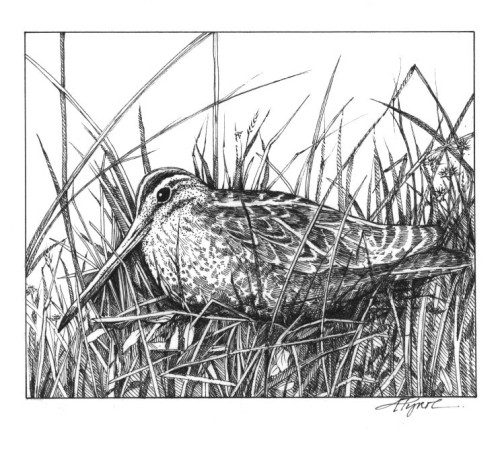
A few years ago, I took my 6-year-old daughter Taylor on a snipe hunt. Not the kind of snipe hunt that most people are familiar with a seemingly endless search for absolutely nothing at all, in which the leader is aware that the hunt is for nothing while his naive followers think they are searching for something quite exciting. No, Taylor and I were trying to find something quite real, the nest of Gallinago gallinago, the common snipe.
Members of the shorebird family, common snipe are relatively widespread in Vermont and New Hampshire, nesting in a variety of wetland habitats, including bogs, fens, sedge meadows, and alder and willow swamps. Somewhat resembling the American woodcock, to which they are closely related, snipe are less stocky, more streaked, and have a longer bill. Like the woodcock, snipe have large eyes set far back and high on their head, enabling them to see both forward and behind. Their nearly 3-inch-long, flexible bill is used effectively to probe soft soils and peat for worms, snails, insect larvae, and other animal foods.
After wintering in the southern U.S., snipe arrive in northern New England during late
March or early April, and males begin their distinct courtship flights. As they circle high above their chosen territories, males go into a short dive that increases their flight speed to between 25 and 50 miles per hour. During these dives, which may occur from one to several times per minute, their tail feathers are spread, causing air to vibrate the outer two tail feathers, which produces an eerie winnowing sound woo-woo-woo-woo. I am frequently asked what the strange sound is, and have had it described to me in some very creative ways. One woman visiting Vermont from the southwest described the sound by demonstrating a native American dance while tapping her hand against her open mouth. Another described it as one of the sounds made by Curly of the Three Stooges.
We have a small pond and fen (a bog-like wetland that accumulates peat) behind our house, which is home to a pair of snipe each year. I like to lie on my back on the lawn and follow the male with binoculars as he circles our property and the adjacent hayfield announcing his territory. If the angle is right, as the bird begins to accelerate into his dive, I can clearly see him spread apart his rather short tail feathers a moment or two before the sound reaches my ears.
That year, Taylor’s patience and binocular-steadying skills were sufficient to allow her to follow these territorial flights herself, leading to a multitude of whys, hows, wheres, and what-fors about snipe biology. After I had answered the questions that I knew and consulted books for the ones I didn’t know, we felt pretty certain that “our” snipe pair were incubating eggs. It was then that Taylor matter-of-factly said, “So, let’s find the nest.” And thus began our snipe hunt.
We had learned that the female snipe selects the nest site. Beginning with a simple scrape on moist but unflooded ground, she then adds layers of vegetation to the nest as the eggs are laid, often resulting in a canopy over the top of the nest. We also knew that her four, heavily blotched, buff-colored eggs in addition to being concealed would be wellcamouflaged. We developed a plan to start our search in one small area where we presumed the nest to be located and then continue by working outwards in concentric circles (a concept which took a little explaining). Finally, we pulled on some old sneakers and set off into the cool, shallow water of the fen, carefully searching around willow thickets and sedge hummocks.
After 30 minutes of searching and being reminded to be careful where she put each footstep, Taylor’s optimism was beginning to wane. I reminded her that if we were to get within a foot or two of the nest, one or both of the adults might feign an injury attempting to distract us. We got distracted all right, several times, though not by the snipe. Once it was by a cluster of white bog orchids framed by several blue flag irises, whose purple blossoms complemented the delicate white orchid spire, requiring appreciation. Another time it was by a pickerel frog that neither of us could catch.
The final distraction, and the end of our snipe hunt, came when Mom arrived home from the store with Popsicles a snipe nest can wait. Popsicles melt!

